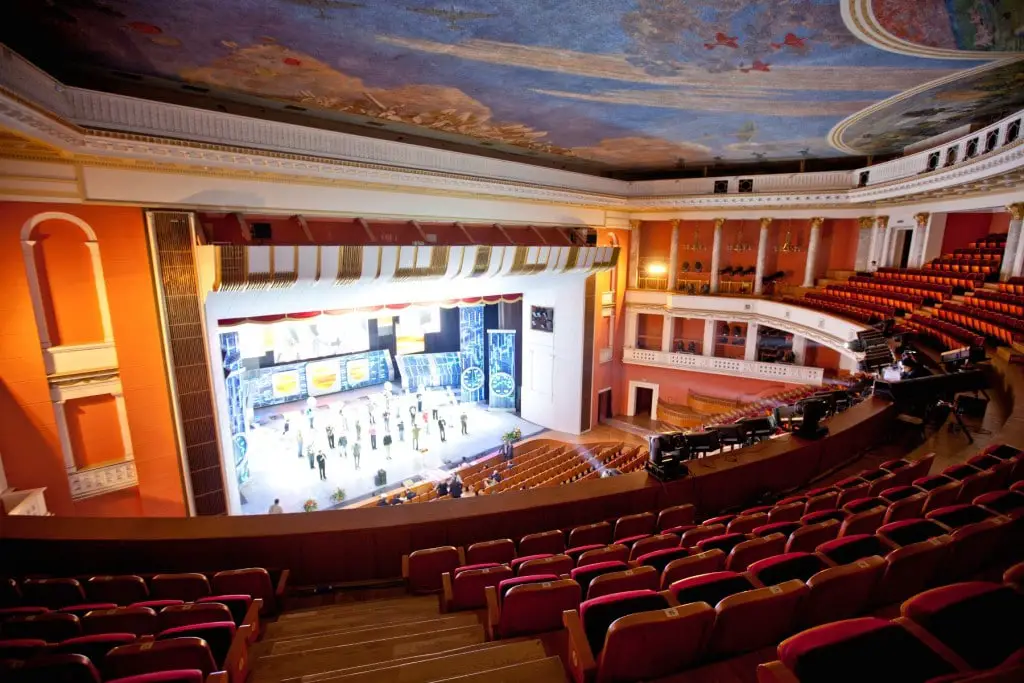How did the economic and political disarray that beset Russia in the days and years following Glasnost affect Russian cultural institutions?
In Russia, theatre practitioners have long enjoyed a social position comparable to Hollywood actors or professional sports stars in America. By the mid-nineteenth century, amateur, provincial, and serf theaters had sprung up in even the most rural parts of Russia. Even today, the populations of Moscow and St. Petersburg support an incredible concentration of theaters.
Under the Soviet system, all theaters were nationalized. While this meant, of course, that there were severe restrictions on the artistic output of the theater, the theater was guaranteed its funds. It should also be mentioned that the Russian theater had thrived since its birth under censorship. The classics of the nineteenth century (Chekhov, Ostrovsky, and the pioneering work of Konstantine Stanislavski) were produced under czarist censorship. While replacing czarist censorship with Soviet did have repercussions, it did not stop art from being produced within Russia, although the Iron Curtain did stop the west from hearing much about it.
When the Soviet system fell, there was a general sense of euphoria as artistic freedom fell upon the theaters. However, that euphoria was soon dampened by the realization that their very survival was dependant upon producing a profit in what had been a heavily subsidized and saturated market. Many theaters folded and those who survived were often at the whim of “New Russians,” powerful businessmen who largely took over their funding and managing. For many theater artists, the dictates of the businessmen were worse than that of the Soviet government. There was a rush to please audiences with old classics or with shocking, new productions, showcasing nudity, profanity, or slapstick. In short, many felt that no new art was truly possible under this system. As if to rub salt in the wound, the businessmen also opened cabarets, nightclubs, and currency exchanges inside the theaters to boost profits.
Many more theaters failed or split due to artistic divisions. The Moscow Art Theater, famed as the birthplace of Konstantine Stanislavski’s “Method System” of acting (now the favored system of Hollywood), split in two. The theater’s ranks had long been bloated with dissidents exiled in the vast ranks of the theatre and hard-line party members rewarded with a place in the prestigious theater alike. This fissure was long patched by government subsidies and control, but could no longer be held in the face of artistic and financial freedom. One MAT became know as the Chekov MAT, and vowed to experiment with artistic style. The other became known as the Gorky MAT, named after the official favorite playwright of the Communist Party and which vowed to maintain the old artistic ideals of the Soviet system. While both MATs are still operating, similar divisions caused the disintegration of other theaters.
Today, the Russian theater is still searching for a new “soul.” Where that soul came from and where it will be found again is still a question. Many say that that soul had once come from a quiet subversion of censorship, others a desire to subvert the west and support communism, and still others from the former financial security of the theater. Opinions about where the new soul will come from are even more diverse. However, things are improving: finances have stabilized for many theaters and the cabarets and currency exchanges have moved out. This is thanks to, in large part, a more indirect system of corporate sponsorship.
The Russian theater is today quite diverse and dynamic, although perhaps still far a new “Golden Age.” American audiences to Russian plays will likely find the plays more “theatrical” than American. Acting and the technical elements of production are more stylized and less “realistic” than in America, where the stage can often imitate the movies. However, this is more an argument to see Russian theater than against. Tourists love the classical stagings of Chekhov (there are currently 4 different productions of the The Cherry Orchard, for instance, in Moscow) and also the visual stimulation available from the more experimental productions (such as those at the Sovreminik or Taganka Theatres).
Theatre attendance is highly recommended while you visit Russia, not only as a taste of an important part of Russian life, but also an artistic view of a national theater being reborn.







